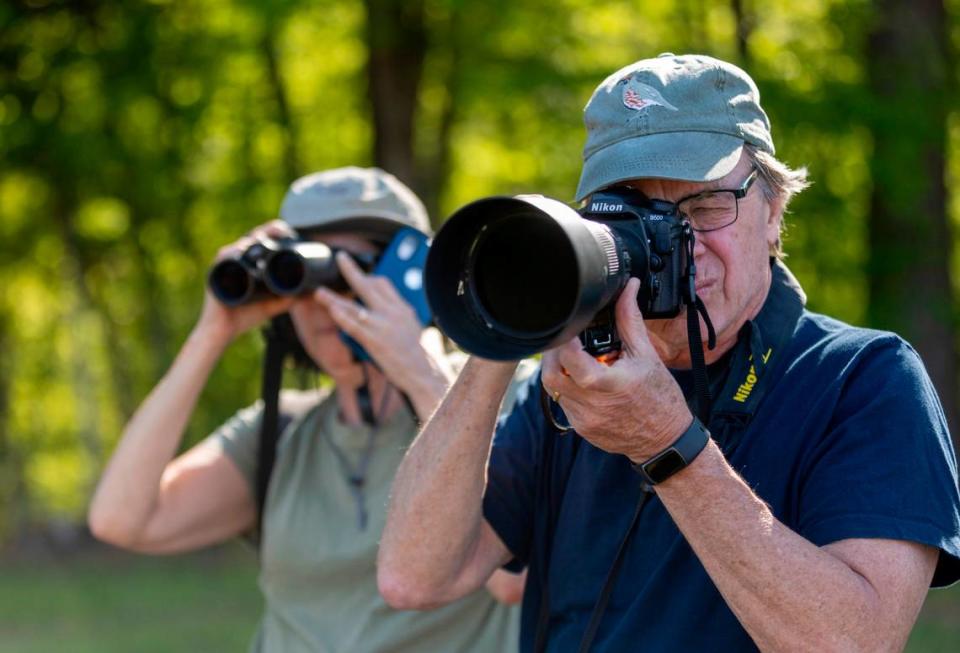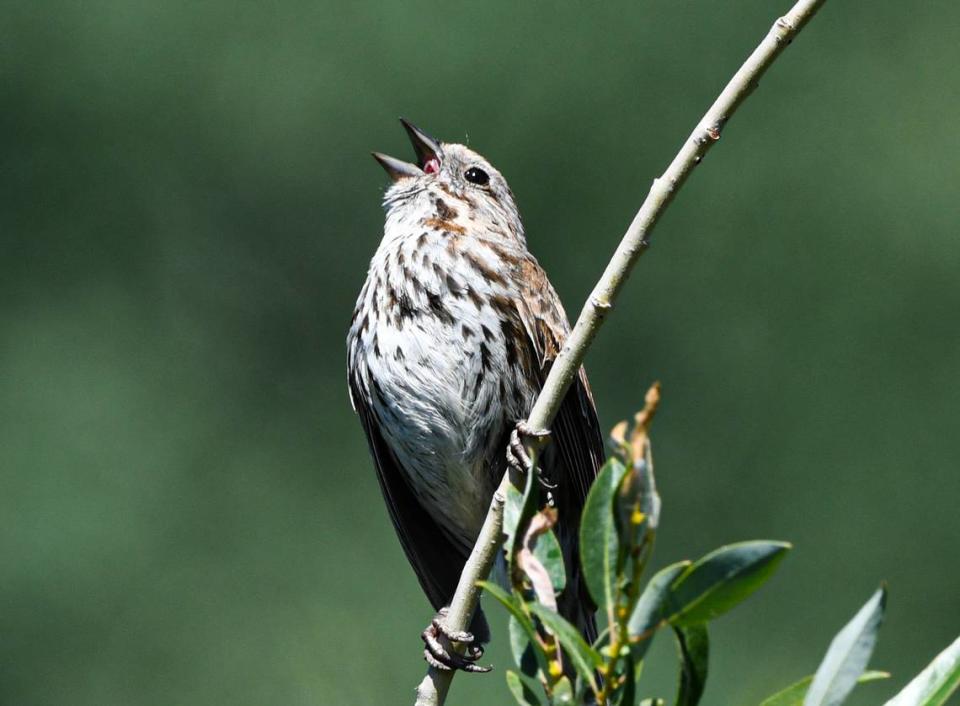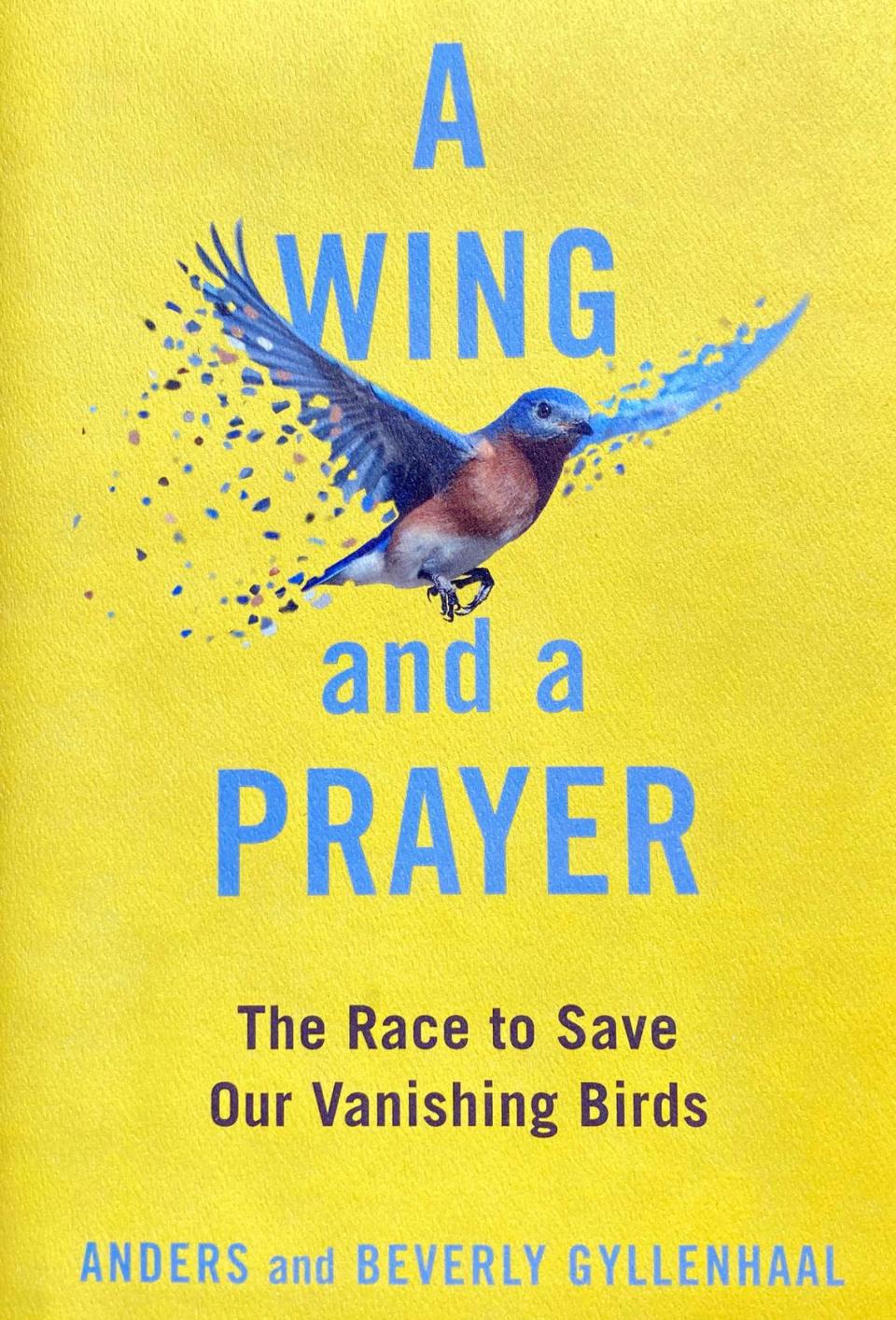As North American bird counts decline, can we turn this around? A new book offers hope.
Sitting under a picnic shelter in an east Raleigh park on a spring day with birdwatchers Anders and Beverly Gyllenhaal is like being on celebrity watch with paparazzi.
One second, they’re talking about the science that inspired their new book, “A Wing and a Prayer: The Race to Save Our Vanishing Birds,” and the next, a flash of brown in the periphery has Beverly snapping her head to see what species just alighted in a nearby tree.
Instinctively, Anders puts one hand on his camera and with the other, snatches up his phone to see what birdsong its Merlin app has identified.
Probably some kind of sparrow, the couple agree, lowering their guard.
The Gyllenhaals are the first to admit that what began a decade ago as a hobby — an antidote to the concrete and glass and the constant traffic of their then-home, Washington, D.C. — kind of took over their lives.
“It became an infatuation,” Anders said. “An obsession, really.”
“Our families make jokes about it,” Beverly said.
It is a little funny to imagine the Gyllenhaals, former editors at The News & Observer and a longtime power couple in McClatchy newspapers, succumbing to the cliche of hiking boots, binoculars and early mornings of retirement spent staring into the skies and treetops for yellow-bellied sapsuckers.
But the startling report about plummeting bird populations that led to their new book is no joke.

The 3 Billion Birds report
In September 2019, the Gyllenhaals had just moved back to Raleigh after 17 years away when the journal Science published what became known as the 3 Billion Birds report. Eleven American and Canadian researchers, analyzing the first-ever overlay of data from decades of spring censuses and Christmas counts with that from national weather radar, concluded that since 1970, North America had lost 2.9 billion birds — a decline of 29% in 48 years.
The report made news across the country, not just because birding was a popular pastime or because a host of government, non-profit and recreational organizations try to monitor the well-being of our avian friends.
Bird health generally is seen as a marker for the health of whole ecosystems; if birds aren’t thriving, the system is in trouble.
The Gyllenhaals, like tens of thousands of other birders, had seen the effects of the decline, though no one had so accurately and shockingly quantified it. In recent years, the couple had bought a travel trailer and begun visiting places historically known as hangouts for non-migratory species or as popular stopovers for birds making twice-annual treks.
In 2018, they had launched a website, “Flying Lessons,” where they touched on avian news, shared photos and videos and blogged about what was to be learned from watching red-shouldered hawks, cedar waxwings, summer tanagers or any of 900 other species that have been recorded on this continent.
Sometimes spending up to six months a year on the road in pursuit of sightings, Anders said, “We had a lot of NOB’s. That’s Not One Bird.”
It’s the birdwatching equivalent of getting skunked.
They chalked up their NOB’s to bad weather, bad timing, bad luck.
But the 3 Billion Bird report suggested something much more serious. The losses were widespread across types and species of birds, and the suspected causes included pesticides, loss of habitat, climate change, shifts in food supplies, unsportsmanlike outdoor cats.
The story of the report was what newspaper people used to call a “talker.” It generated a lot of conversations and had more people paying more attention to the house finches and great crested flycatchers in their back yards.
Then, in early 2020, the pandemic hit. In lockdown, people’s worlds shrank to the square footage of their homes plus whatever outdoor acreage to which they had access. Retailers reported that sales of bird feeders and food nearly doubled as bluebirds and red-winged blackbirds went from background noise to a source of socially distant entertainment.

Timing is everything
Beverly is a former reporter, editor, national food columnist and book author. Anders started out as a reporter and photographer at newspapers in Pennsylvania, Virginia and New Jersey before becoming a line editor and then a top editor for newsrooms in Raleigh, Minneapolis and Miami, and finally for the whole McClatchy chain.
Good journalists know timing is everything, and the Gyllenhaals saw that birds were having a moment. And yet, while bookstores were full of topical tomes, none seemed to be exploring the issue of the avian population decline.
What was really lacking, the couple found, was a book on what might be done to reverse the losses before more species became extinct or the continent’s whole bird population crashed beyond recovery.
“We decided to write one,” Anders said.
Stuart Pimm, the Doris Duke Professor of Conservation Ecology at Duke University, likes that much of the focus of the new book is on recovery efforts. He found the tone of the 2019 3 Billion Birds report to be so shrill, he said, that it could leave people thinking, what’s the point of trying if the birds are all going to die off anyway?
“It’s not something where we want to throw ourselves off a tall building,” said Pimm, who is working in South Africa to encourage local officials to connect areas of wildlife habitat there. “It’s important to get the right mix of gloom and doom and success.
“There a lot of things we can do and a lot of progress that has been made. Most important, we have to look at where birds live. We have to stop killing things and start protecting the places where they live.”

Researching and going on the road
To produce the book, the Gyllenhaals spent nearly a year researching projects aimed at supporting or boosting bird populations, identifying ones that worked on different scales, different species and in varied locations. They found ones that operate on generous grants and shoestring budgets. Some deploy drones and tiny tracking devices, while others rely on old-fashioned animal husbandry. They may enjoy government support or face local skepticism. Some involve captive breeding of rare or threatened species; others try to restore or conserve habitat.
Next, the Gyllenhaals spent a year on the road, often pulling their 23-foot Airstream trailer, having converted the dinette into a desk and stuffed the cabinets with office supplies instead of vacation clothes. They went south, then west across the country, then north and finally back home.
They spent 2022 writing about the 300-odd people they had interviewed, the projects they had seen, the birds they had spotted, the mosquitoes they had fed, the mud that was still caked on their shoes.

The book, published by Simon & Schuster and released in late April, revisits the 3 Billion Bird report in layman’s terms and demystifies the research that went into it, explaining even the genesis of the calculations as basically a newcomer to the bird world daring to voice the obvious but unasked question. Do we know how many birds we’ve lost?
More than just amplifying the now-four-year-old findings, the authors are thorough in explaining why it matters that birds have disappeared: They’re a critical part of the ecosystem and if they can’t survive on the continent or in the world, other life forms may not make it either.

The book argues for urgent action, including the passage of the federal Recovering America’s Wildlife Act, and adequately funding the U.S. Fish & Wildlife Service. The authors note the human tendency to wait until absolute crisis conditions before moving on big problems, but quote researchers who say the longer it takes to act, the harder and more expensive it will be to find solutions.
The writing about bird science is clear and accessible, and the descriptions of some of the birding forays are so engaging they’ll have readers downloading that free Merlin app and making an account on ebird.org to tally the species they see with their own eyes.
The authors’ main goal with the book is to inspire people to do what they can to save birds. They remind readers of heroic efforts that were successful in the past:
▪ Rachel Carson’s 1962 book “Silent Spring” that resulted in a ban on DDT, spawned an environmental movement and the creation of the Environmental Protection Agency.
▪ the subsequent recovery of the bald eagle.
▪ the conservation of more than 12.4 million acres of wildlife habitat in the U.S., Canada and Mexico by Ducks Unlimited.
▪ and the military’s recalcitrant but eventually thorough embrace of the need to protect the long-leaf-pine habitat of the red-cockaded woodpecker.
“A Wing and a Prayer” introduces dozens of people across the country trying to conserve the grassland birds, the forest birds, the wetland birds, the common backyard birds. It tells some great stories, including one full of intrigue and deceit about the quest to prove the elusive ivory-billed woodpecker still exists, though none has been documented since the 1940s.
The Gyllenhaals employ the best tools of good journalism: solid research, immersive description, great characters, compelling stories and clean writing.
“We want to make people care about this,” Beverly said.
Her husband, looking over his camera, added, “And we want to give them hope.”
Raleigh book event
Anders and Beverly Gyllenhaal will read from their book, “A Wing and a Prayer: The Race to Save Our Vanishing Birds,” at Quail Ridge Books in Raleigh on Wednesday, May 10, from 7-8 p.m. Tickets are available through Eventbrite and include the cost of an autographed copy of the book.
What’s it like to go birding? I joined an Audubon group outing in Durham to find out
Experts recommend these birding apps for beginner or skilled bird watchers

